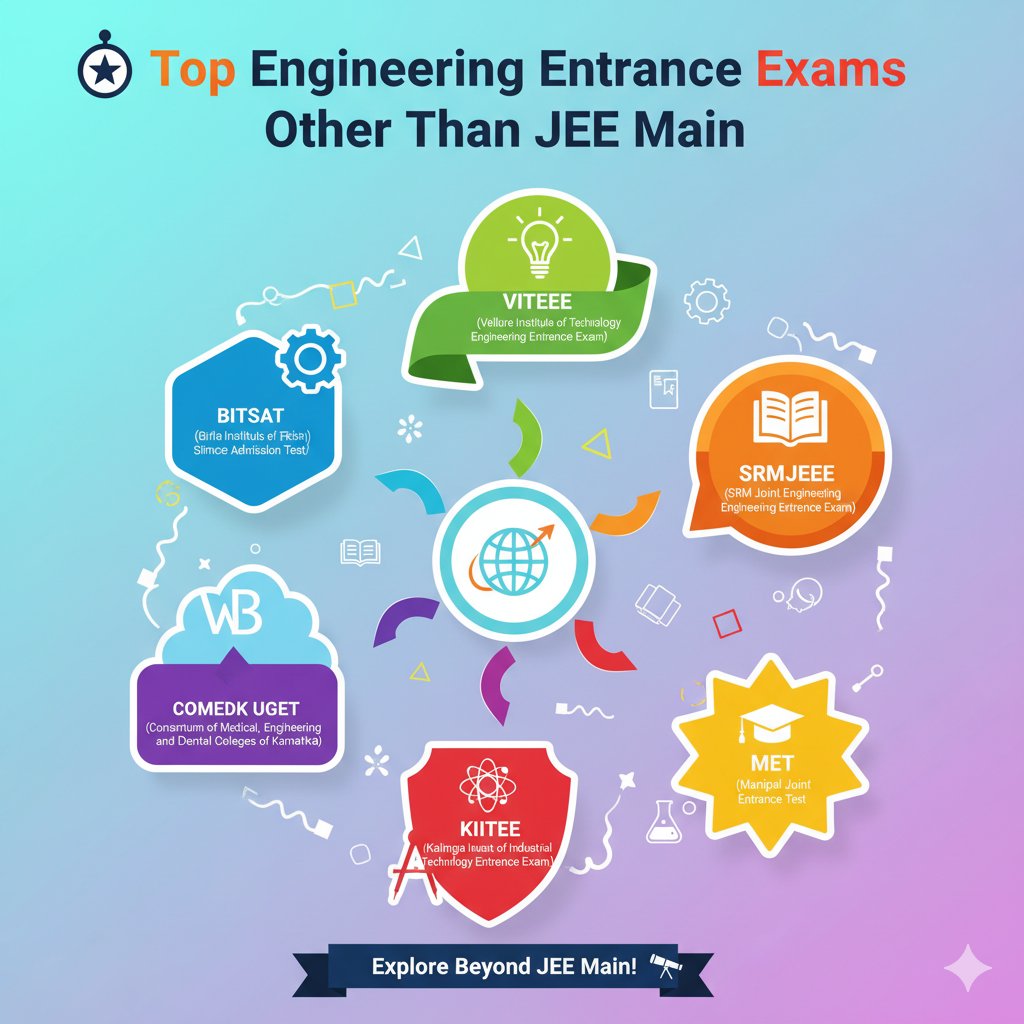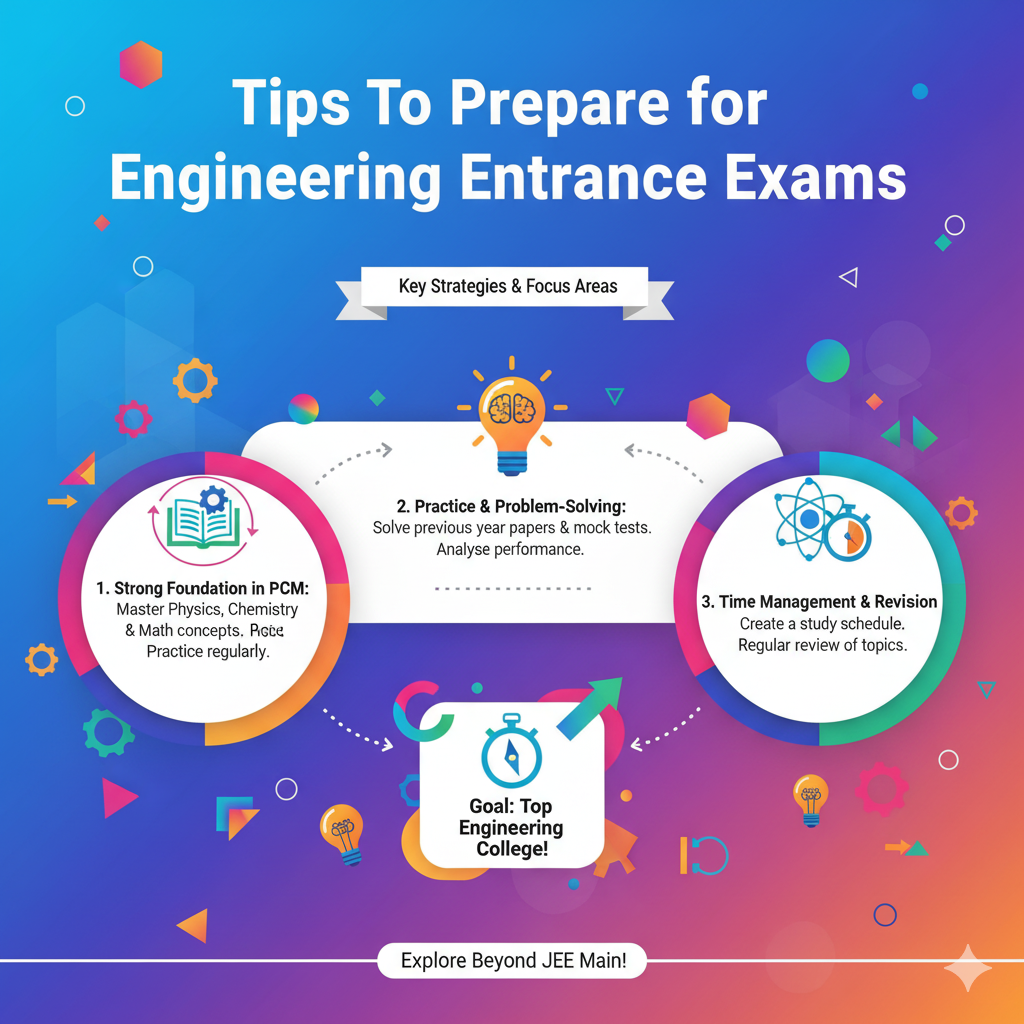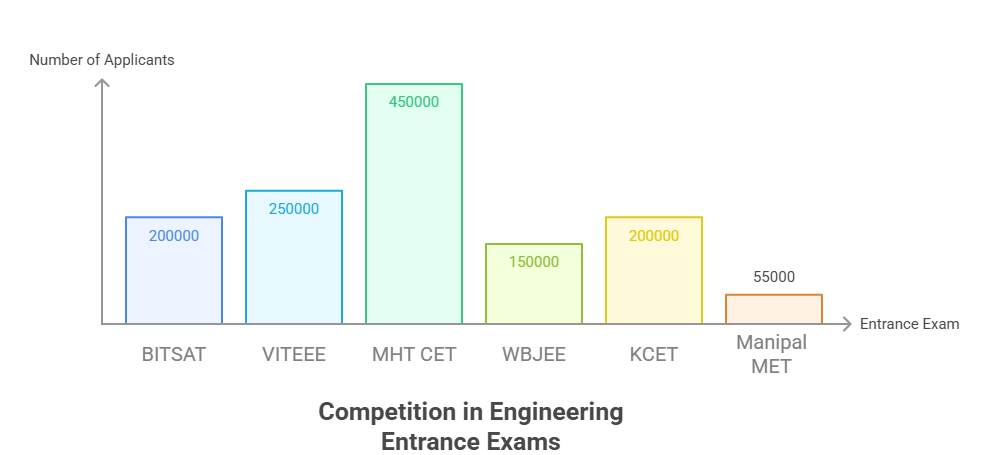One of the most common career decisions in India is the field of engineering where lakhs of students would take the entrance examination annually. Although the Joint Entrance Examination (JEE) is a major alternative, most students look at other engineering entrance examinations at the national, state and university levels. Such alternative exams are by well-known institutes and state education boards, which give broader chances of admission to top colleges.
The selection of the correct entrance exam is dependent on personal career choice, the preferred institute and the eligibility criteria. This blog will address the best engineering entrance exams besides JEE, its eligibility, how it is conducted, methods of preparation, and statistics of admission.

Engineering entrance exams other than JEE Mains provide students with multiple pathways for admission to quality engineering colleges across India, expanding opportunities beyond the JEE exam.
GATE (Graduate Aptitude Test in Engineering) is an exam of postgraduate engineering course admissions and PSU recruitments at a national level. It examines applicants in engineering courses, science and aptitude.
IITs, NITs, IISc and other universities accept GATE scores to M.Tech, ME and PhD programs. The test is conducted on-line and in multiple-choice and numerical answer format. The qualification must be a bachelor degree in engineering or science.
GATE is very competitive and provides opportunities in higher learning as well as in government sector employment thus becoming very necessary to those individuals who are interested in higher education or in taking up technical employment.
Undergraduate admissions to most of the central universities in India are done through CUET (Common University Entrance Test).
Those students who want to pursue engineering in engineering colleges like Delhi University and BHU are required to pass CUET. The test is computer-based and tests students on Physics, Chemistry, Mathematics and aptitude parts.
The eligibility is 10+2 science stream. CUET enables several participating universities to receive simultaneous applications at once through one test score, which simplifies engineering admissions and makes them more accessible in a large variety of schools.
There is an entrance test called BITSAT (Birla Institute of Technology and Science Admission Test) which is used in the admission to the BITS campuses located in Pilani, Goa, and Hyderabad. It is administered on-line and has multiple-choice questions based on Physics, Chemistry, Mathematics, English and Logical Reasoning.
75% aggregate in PCB/PCM in 10+2, of which at least 60% in each subject. BITSAT has a distinctive question pattern, speed-based testing, and competitive cutoffs. Upon successful selection, successful candidates are placed in one of the best of the Indian private engineering colleges, with good placements and research opportunities.
WBJEE (West Bengal Joint Entrance Examination) is an engineering test conducted by the government of West Bengal and private colleges that is an examination used to grant admission to engineering students in West Bengal.
The test consists of objective questions primarily of Physics, Chemistry and Mathematics. The requirements are 10+2 with PCM and the candidate will also be required to meet the domicile requirements in some seats.
WBJEE has become one of the main avenues where students wish to get cheap and quality engineering studies in the state, with a wide participation and clearly laid counseling procedures to distribute seats in different institutions.
Odisha Joint Entrance Examination (OJEE) is a state-level engineering, pharmacy, and other professional examination of Odisha colleges. It comprises PCM objective questions to engineering candidates.
The eligibility includes the 10 + 2 with the science subjects. OJEE is especially recognized to accept students to B.Tech, M.Tech, MBA, and MCA programmes in Odisha. It is a very crucial entry point to students who intend to pursue engineering in Odisha as counseling is centralized and seat allocation is done on the basis of merit and preferences.
MHT-CET (Maharashtra Health and Technical Common Entrance test) is the primary exam which is used to admit students to the engineering courses of the government and the privatized institutions in Maharashtra.
It is carried out once a year in an online mode, having Physics, Chemistry and Mathematics sections. The applicant should possess 10+2 in PCM. There are a large number of applicants annually because of availability of wide seats and relatively low costs in government colleges.
MHT-CET is recognized by leading institutes of Maharashtra and has a reputation of high enrollment and transparency of the counseling process.
The entrance examination to the engineering courses in Rajasthan was RPET (Rajasthan Pre Engineering Test) now replaced by REAP (Rajasthan Engineering Admission Process). RPET was paper-based and examined the students on PCM matters.
The criteria were 10+2 science streams. RPET was used to take entry into government and private engineering colleges in Rajasthan whereby the allotment of seats was done via centralized counseling.
The exam was characterized by the uncomplicated structure and its availability to most universities within the state.
COMED-K UGET (Consultative Medical, Engineering and Dental Colleges of Karnataka) is a private engineering entrance test in Karnataka open to all students of India. It examines candidates in Physics, Chemistry and Mathematics. Eligibility is 10+2 with PCM. COMED-K offers admission to more than 180 leading private colleges in Karnataka.
The online test is characterized by such aspects as competitive environment, large coverage and equitable distribution of seats through centralized counseling. It is particularly handy to students who could not qualify by KCET or students who wanted to join a private institution.
GUJCET (Gujarat Common Entrance Test) is an engineering entrance exam of Gujarat. It examines students based on Physics, Chemistry and Mathematics and to be eligible one must pass 10 +2 with science stream.
GUJCET is used as the first means of access to seats in government and private colleges in Gujarat. The test is paper based and has a high number of candidates annually and the assignment of seats is done through a centralized counseling. Domicile regulations can be used in admission to government quota.
Karnataka Common Entrance Test KCET (Karnataka Common Entrance Test) is an engineering admission test in Karnataka, which is used to gain entry to a government, aided, and private college. The test is offline and it touches upon PCM subjects. The qualification is 10+2 with PCM in a registered board.
Students of Karnataka have a preference in KCET, but other categories also allow other students to be admitted to this institution. It is perfect to individuals who want to acquire affordable engineering education in Karnataka considering that state quota and reservation policies are applicable. Counseling provides an open seat distribution.
The engineering and pharmacy courses in Goa use an entrance exam, GCET (Goa Common Entrance test). It examines students in PCM with easy multiple choice questions. Qualifications are 10+2 with science in a recognized board.
The GCET admits domicile students of Goa and a few students of other states. The test is brief and the Directorate of Technical Education, Goa does the counseling. Those who have the ambition of joining good colleges in Goa will find it very important.
| Exam | Level | Main Subjects | Format | Eligibility | Area Covered |
|---|---|---|---|---|---|
| GATE | National | Engineering, Aptitude | Online MCQ/NAT | B.Tech/B.Sc/Equivalent | India/PSU/Masters |
| CUET | National | PCM (+ Aptitude) | Online MCQ | 10+2 (Science) | Central Universities |
| BITSAT | University | PCM, Eng, Reasoning | Online MCQ | 10+2, ≥75% PCM | BITS Campuses |
| WBJEE | State | PCM | Offline MCQ | 10+2 (PCM), Domicile | West Bengal |
| OJEE | State | PCM | Offline MCQ | 10+2 (Science) | Odisha |
| MHT-CET | State | PCM | Online MCQ | 10+2 (PCM) | Maharashtra |
| RPET | State (old) | PCM | Offline MCQ | 10+2 (Science) | Rajasthan |
| REAP | State | Merit/JEE Main | No Test | 10+2, JEE Main | Rajasthan |
| COMED-K | Private | PCM | Online MCQ | 10+2 (PCM) | Karnataka Privates |
| GUJCET | State | PCM | Offline MCQ | 10+2 (Science) | Gujarat |
| KCET | State | PCM | Offline MCQ | 10+2 (PCM) | Karnataka |
| GCET | State | PCM | Offline MCQ | 10+2 (Science) | Goa |

Discipline, strategy and practice are essential in preparing for engineering entrance examinations other than JEE. These are just some of the tips that should enable the students to do better.
The entrance exam is a matter of choice and varies according to several factors.
The first is the kind of college you desire to study in. As an example, you would want to study in one of the best private institutes; it has all the modern infrastructure, in this case, you would have to take exams such as BITSAT, VITEEE, SRMJEEE or KIITEE. Students who desire to be in inexpensive government colleges must focus on governmental level exams such as KCET, WBJEE or MHT CET.
The other aspect is eligibility. When you are not a domicile of a certain state, it does not necessarily qualify you to take its state entrance examinations. In the same manner, the university exams of all states are accessible by privates as well. The pattern of the exam also ought to be taken into consideration. In case you are not afraid of the logical reasoning exams or English, you may select exams such as BITSAT.
In making decisions, students must put in consideration their long-term objectives. As an example, in case you desire to have international recognition, BITS Pilani or Manipal University has an advantage. Conversely, state-level exams are superior in case of affordability and government certification. The benefit of taking more than one exam is that you have a better opportunity of getting a seat and you are not reliant on a particular exam.
.png&w=1920&q=75)
Recent case studies on the trend of admissions in the last two years indicate that there is a high degree of competition amongst engineering entrances beyond JEE.
As an illustration, BITSAT was receiving over 2 lakh applications per year when the number of seats that existed in its campuses was about a few thousands.
VITEEE, in contrast, attracts more than 2.5 lakh applications every year and there are approximately 5000-6000 seats (estimate) on Vellore, Chennai and other campuses.
The exams at the state level such as MHT CET are the most participated exams with an estimated number of 4-5 lakh students appearing annually to compete and secure places in government and private institutions in Maharashtra.
Approximately 1.5 lakh applicants are registered by WBJEE annually, and 2 lakh-plus candidates are expected to be observed in KCET. Manipal MET has 50-60,000 applicants each year and much less number of seats.
These figures indicate that these exams are very competitive and tend to change every year for each course and specialisation.
Engineering as a profession is still in demand and though the amount of people applying has not decreased, with proper preparation, you can snatch a seat. Therefore, although JEE is famous, other tests equally require the attention of students who want to study in quality colleges.
Note: These figures are a rough estimate not the exact numbers.

Top Engineering Colleges in India 2025







Articles recommended for you

CUET PG

college

college

college

college

college

college

college

college

college
Chat with us